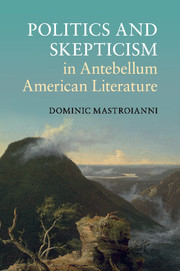Book contents
- Frontmatter
- Contents
- Acknowledgments
- Introduction: secret springs
- Chapter 1 Moods and the secret cause of revolution in Emerson
- Chapter 2 Revolutionary time and democracy’s causes in Melville’s Pierre
- Chapter 3 Hawthorne and the temperatures of secrecy
- Chapter 4 Causes of falling, Civil War, and the poetics of survival in Dickinson’s Fascicle 24
- Conclusion: antislavery writing, skepticism, and scorching words
- Notes
- Index
Chapter 3 - Hawthorne and the temperatures of secrecy
Published online by Cambridge University Press: 05 November 2014
- Frontmatter
- Contents
- Acknowledgments
- Introduction: secret springs
- Chapter 1 Moods and the secret cause of revolution in Emerson
- Chapter 2 Revolutionary time and democracy’s causes in Melville’s Pierre
- Chapter 3 Hawthorne and the temperatures of secrecy
- Chapter 4 Causes of falling, Civil War, and the poetics of survival in Dickinson’s Fascicle 24
- Conclusion: antislavery writing, skepticism, and scorching words
- Notes
- Index
Summary
In his famous speech titled “What to the Slave Is the Fourth of July?” (5 July 1852), Frederick Douglass praises the virtues of heat. He portrays as cold the failure of the United States to “extend” to its black population “the great principles of political freedom and of natural justice, embodied in that Declaration of Independence.” It would be easy for him to celebrate U.S. independence, says Douglass, if the United States had acted warmly by distributing political rights more widely: “For who is there so cold, that a nation’s sympathy could not warm him?” Although Douglass’s speech offers an illuminating account of American Revolutionary history, he insists that the times call for fire rather than light:
At a time like this, scorching irony, not convincing argument, is needed. O! had I the ability, and could I reach the nation’s ear, I would, to-day, pour out a fiery stream of biting ridicule, blasting reproach, withering sarcasm, and stern rebuke. For it is not light that is needed, but fire… The feeling of the nation must be quickened; the conscience of the nation must be roused.
Douglass would like to be, like Kant’s Hume, the spark that ignites an awakening, a rouser of the sleeping. It is a cold nation, suggests Douglass, that oppresses part of its population. Such coldness is to be dispelled not by a gentle warming, but by the shock of fiery heat.
- Type
- Chapter
- Information
- Politics and Skepticism in Antebellum American Literature , pp. 83 - 118Publisher: Cambridge University PressPrint publication year: 2014



